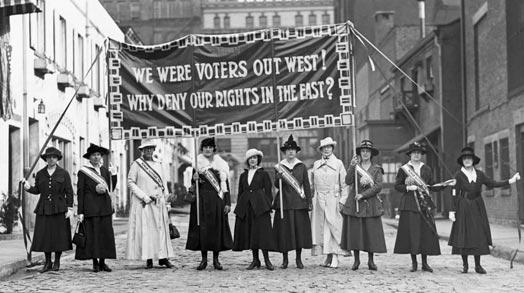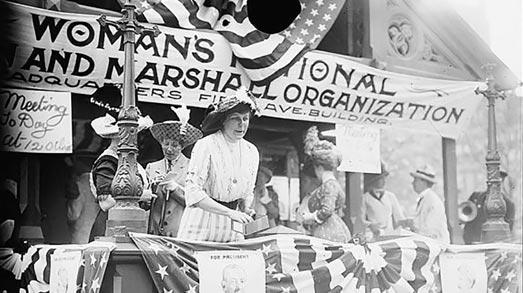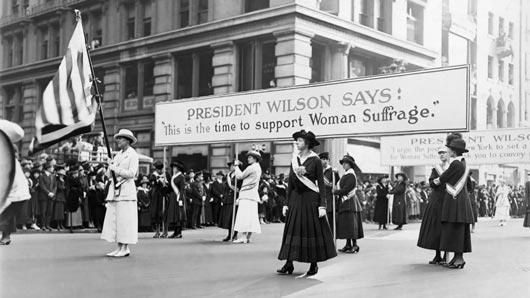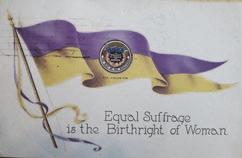
23 minute read
Feature: Suffering for Suffrage
Suffering for Suffrage

Advertisement

by Janice P. Dreiling
The first public demand that women be allowed to vote came from the Seneca Falls, New York, Convention of 1848, 72 years after the Declaration of Independence proclaimed “all men are created equal, that they are endowed by their Creator with certain unalienable Rights, that among these are Life, Liberty and the pursuit of Happiness.” It did not occur to the “signers” to include women. It would be another 72 years before the 19th Amendment — stating the right of citizens to vote shall not be denied or abridged on account of sex — would become part of the U.S. Constitution.
From 1848 to 1920, suffragists witnessed 17 Presidents of the United States, the population grow from 23 to 106 million, and the number of States increase from 30 to 48. At first travel was by steamboat, canal boat, stagecoach, wagon, horseback, and on foot. Travel by train was in its infancy. Communication consisted of newspapers, handbills, letters and lecturers. Telegrams did not
come along until 1861, and the telephone not until 1876. tionists themselves, condemned the women.
Most of the women who started the movement died before it was over. And none of the thousands of women marchers in the 10 years prior to the amendment’s ratification in 1920 had been born when the movement started.
Why did it take so long? The short answer is change is not acceptable to the powers that be, the powers that profit from the way things are.
The long answer includes the obstacles and relentless opposition suffragists faced.

Prevailing mores of 1848 dictated women’s “sphere” was the home, and men’s “sphere” was everywhere else. Women were not to speak in public.
In the 1830s, when some women joined abolitionist groups and a few spoke out, the religious leaders of the day, joined by many of the male aboliSuffragists Susan B. Anthony and Lucy Stone were paid lecturers for the Anti-Slavery Society before they began
A Look at the 72-Year Struggle for Women’s Right to Vote



suffrage work. Anthony said that what was hurled at her when she arrived in a town to speak were the words of Paul in 1 Corinthians 14:34-35, “Let your women keep silence in the churches; for it is not permitted unto them to speak; but, they are commanded to be under obedience, as also saith the law. And if they will learn any thing, let them ask their husbands at home: for it is a shame for women to speak in the church.” That scripture was interpreted to restrict women to speaking in their homes. juries. Single women did not fare much better — but they were taxed the same as men!
Press and clergy alike ridiculed the 1848 Seneca Falls Convention, in particular Resolution 9, “Resolved, that it is the duty of the women of this country to secure to themselves their sacred right to


Domestic law in 1848 was that husband and wife became “one” and that one was the husband, that married women had almost no rights to property, earnings, or their own children. Husbands could chastise their wives, including physical punishment. Women could not enter contracts or be admitted to most colleges, professions, or occupations, nor serve on the elective franchise.” They feared it would result in a societal “sea change,” that women would abandon their responsibilities to home and husband.
Woman suffrage was fought every step of the way by the patriarchy that controlled every branch of government, state and federal. Opposition was relentless. Even after Tennessee ratified the 19th Amendment in August 1920, becoming the last state needed, a lawsuit was filed by a Baltimore attorney, Oscar Leser, to have women’s names removed from the voting rolls for the reason the State Constitution allowed only men to vote and the Maryland Legislature had not ratified the 19th Amendment. A unanimous U.S. Supreme Court February 27, 1922, turned down Leser’s challenge.
There, women performed every role in family and community in the absence of their husbands working in the whaling industry, Mott became a Quaker minister. Quakers believed the “inner light of Christ” was in every human being. Accordingly, Quakers practiced total equality. Many became active in the Abolition Movement in the early 1800s when abolition of slavery was not popular. Being an abolitionist was dangerous, particularly if one spoke publicly in favor of abolition, as did Mott, wife and mother of six. She was elected a delegate to the World Anti-Slavery Convention in London in 1840.
Mott and other women delegates were denied their seats in London because they were women. They were forced to sit behind a partition and forbidden from any participation. It was there that Mott met the young Elizabeth Cady Stanton, whose husband, Henry, was also an elected delegate. They were on their honeymoon. Elizabeth, then 25, heard Mott preach. She had never heard a woman speak in public, let alone preach. Stanton and Mott became friends and vowed that upon returning home, they would convene a meeting to address the “social, civil, and religious condition and rights of women.” That meeting would be the Seneca Falls Convention of 1848.
three other women, Mott and Stanton organized the first ever “woman’s rights convention” and publicized it by a single notice in the Seneca Falls Courier. That notice generated attendance by over 300 women and men. The two-day convention resulted in the adoption of 11 resolutions concerning women’s rights.


In 1848, nowhere in the world did women have the vote. And even Mott questioned Stanton’s inclusion of resolution nine about women voting. This was the only controversial resolution. Stanton’s husband, Henry, told her if she included resolution nine, he would not attend. A former slave, abolitionist, publisher, and women’s rights activist, Frederick Douglass attended the Seneca Falls Convention and spoke in favor of Stanton’s resolution nine. It was passed after much debate.
Two weeks later a second convention was held in nearby Rochester, and the “floodgates” were opened. Local and state “Woman’s Rights Conventions” happened everywhere throughout the Northeast and Ohio. The frequency of these meetings allowed the emerging suffrage leaders to bond and establish a network. Press coverage made Lucretia Mott, Elizabeth Cady Stanton, Lucy Stone and Susan B. Anthony household names all over the country.
Other than church groups, there were no women’s groups outside the home in 1848. The New York City Sorosis Club, the first women’s professional club in the country, was established in 1868 when the New York Press Club refused to admit women. The Women’s Christian Temperance Union (“WCTU”), the biggest women’s organization in the second half of the 19th century, was not established until 1873.
In 1850, the first “National Woman’s Rights Convention” was organized by Lucy Stone, in Worcester, Massachusetts, drawing over 1000 people. Annual “National Conventions” followed until the Civil War in 1861. Note that it was “woman’s rights” and not just “woman
suffrage” that brought women and men to these meetings.

tions as time would allow. But both ques tions lost.
During the Civil War (1861-1865) suf fragists shut down except for a huge effort by Stanton and Anthony to help pass the 13th Amendment that abolished slavery. Establishing the Woman’s National Loyal League, in 1863, they accumulated 400,000 signatures of women and men across the country to attach to Petitions urging Congress to pass the Amendment, ratified in 1865.
Early in 1867, the Kansas Legislature proposed two state questions to appear on the November ballot. One, to amend the Kansas Constitution by striking the word “white” from voter qualifications, thus allowing blacks to vote. Two, to strike the word “male.” It was the first time Woman Suffrage had appeared on the ballot of any State.
Lucy Stone and husband, Henry Blackwell, Olympia Brown, Elizabeth Cady Stanton and Susan B. Anthony all went to Kansas. But, the Kansas Repub lican party and abolitionist groups in the East abandoned the Woman Suffrage question in favor of Black Suffrage only.
By September when Stanton and Anthony arrived, their organization, the American Equal Rights Association, was out of funds. When a wealthy, well known businessman, George Francis Train, appeared to promote Woman Suffrage at the end of the campaign, they accepted him, appearing with him in as many loca The news of Train campaigning with Anthony and Stanton horrified Lucy Stone and others. Train was a known racist, southern sympathizer, and a Democrat. Accusations flew, resulting in a split between supporters of Anthony and Stanton and supporters of Stone.

By late 1869, there were two national organizations working for Woman Suf frage, Anthony and Stanton’s National Woman Suffrage Association (NWSA) and Stone’s American Woman Suffrage Association (AWSA). The two groups competed for membership, funding and pub licity for two decades, merging in 1890.
In what they called “a new departure,” Anthony and Stan ton concluded Section One of the 14th Amendment, ratified in 1868, gave women the right to vote, even if unintended. The words “No State shall make or enforce any law which shall abridge the privileges or immunities of citizens of the United States” convinced them that women had the vote already. Weren’t women citi zens? Wasn’t voting a privilege of citizenship?
To test their conclusion, Suffragists voted or attempted to vote in 10 States in the 1872 Presiden tial election. Anthony and 14 other women registered and voted in Rochester, NY. This daring act of voting made headlines everywhere. On Thanks giving Day, Anthony was arrested on the charge of “Voting without a Lawful Right to Vote,” a federal felony punishable by a fine and possible prison time.
President Grant’s newly appointed Justice of the U.S. Supreme Court, Ward Hunt, was specially assigned to the case, set for trial in July 1873 to an all-male jury. Judge Hunt ruled Anthony was incompe

tent to testify because she was a woman. When both sides rested, Hunt directed a verdict of “guilty,” something unheard of in criminal law. He dismissed the jury. The Courtroom had been packed with politicians and a former President of the United States, all anxiously awaiting the outcome.
Had the jury found Anthony “not guilty,” there would be no denying women the constitutional right to vote almost 50 years before it was allowed by the 19th Amendment. The powers that be did not want that to happen.
Prior to sentencing Anthony to pay a fine of $100 and the court costs, Hunt asked if she had anything to say. In the heated exchange that followed, he said “the prisoner has been tried according to the established form of law.” Her response, “Yes, your Honor, but by forms of law all made by men, interpreted by men, administered by men, in favor of men, and against women; and, hence, your honor’s ordered verdict of guilty, against a U.S. citizen for exercising that citizen’s right to vote simply because that citizen is a woman and not a man.”
It would be suffragist Virginia Minor, who attempted to vote in Missouri in the same election, who appealed to the Supreme Court in Minor vs. Happersett. In 1875 a unanimous decision ruled that although Minor was a citizen, the U.S. Constitution did not confer the right of suffrage on anyone, that it was up to the individual States to decide who voted. For the next 35 years, suffragists focused on campaigns to amend state constitutions.


By 1910, only four States in the thinly populated West - Wyoming, Utah, Colorado and Idaho – had extended voting rights to women. Anthony, Stanton and Stone had died. A new generation of leaders, Carrie Chapman Catt and Anna Howard Shaw, led the conservative National American Woman Suffrage Association (NAWSA). Woman Suffrage was in the doldrums.
Much had changed for women in their access to higher education and some professions, and some state statutes against women had been repealed, but NAWSA had lost membership and funding and didn’t even have an office in Washington, D.C.
Washington State amended its Constitution allowing full suffrage to women in 1910; California followed in 1911. In England, some suffragists committed acts of civil disobedience, for which they were jailed. The Women’s Social and Political Union (“WSPU”), led by Emmeline Pankhurst, encouraged its members to break windows, shout down opponents in Parliament, start fires, and hunger strike if they were arrested.

Two young American women, pursuing graduate studies, were caught up in England’s suffrage effort. Alice Paul and Lucy Burns met in a London jail. They had both been arrested multiple times while working for Mrs. Pankhurst’s WSPU.
grown up in a wealthy New Jersey family, attending NAWSA meetings with her mother. When Paul heard Christabel Pankhurst speak in 1908, it was an awakening. Paul dedicated the rest of her life to woman suffrage and woman’s rights. the status of the American movement was, this said it all.


In 1912, Lucy Burns returned. She and Paul vowed they would jump-start the Woman Suffrage Movement. It had been 64 years since Seneca Falls.
Due to Paul’s prominent family and the fact she was repeatedly jailed, participating in hunger strikes and enduring force feedings, the press covered her English suffrage activities extensively. When she returned to the U.S. in 1910 at age 25, she was well-known and much sought after as a speaker.
Anna Howard Shaw, President of NAWSA, invited Paul to the annual convention in Washington, D.C. Paul was to speak after U.S. President William Howard Taft welcomed the delegates. Taft, a woman suffrage opponent, insulted every woman in the room by claiming if women got the vote, only women who were undesirable would vote while the intelligent and patriotic women would stay home. A “hiss” spontaneously emerged from the delegates, audible to the President. Following Taft’s exit, Shaw chastised the delegates for their rudeness and unladylike behavior and sent a letter of apology to the White House. If Paul had wondered what
Paul and Burns joined NAWSA, taking over its Congressional Committee with its $10 a year budget to work for a federal amendment. They were told if they needed more they would have to raise it.
March 3, 1913, Paul and Burns produced a spectacular parade in Washington D.C. Carrying banners with suffrage colors of purple (justice), white (purity) and gold (courage), 8000 women marchers were carefully organized in groups by state or profession or university. It was the day before Woodrow Wilson’s inauguration as President. The parade ended in chaos. Crowds of men lined the streets, in anticipation of inaugural festivities. Some became angry, seeing women march. They threw rocks and moved in on the marchers. Police failed to act, telling the women if they had stayed home, they would not be in danger. Some went to the hospital and a cavalry unit had to be called to restore order.
The parade brought attention back to woman suffrage, just as Paul and Burns had planned. It did not start their relationship with the new President well. When Wilson arrived by train, expecting a large crowd, he was told everyone was at the Suffrage parade.
Paul and Burns continued to work for NAWSA as the Congressional Union. But their success at fund-raising, publicity and attracting volunteers threatened the older NAWSA leaders, concerned Paul and Burns would resort to militant tactics they learned in England. Paul was a Quaker, raised in a tradition of non-violence. Her strategy may have been abrasive, but it was never violent.
Paul and others met with President Wilson, asking him to support woman suffrage. His reply, at the end of a 10- minute meeting, was he had more important issues to deal with, specifically currency and tariffs. Little did Paul know then there would always be more important issues for Wilson.

supported woman suffrage. This was the last straw for Mrs. Catt and Dr. Shaw. They expelled Paul and Burns and their Congressional Union from NAWSA, calling their behavior “unwomanly.”

By 1916, a presidential election year, there were 11 full-suffrage states. Paul repeated her 1914 strategy, sending her best speakers to those states. Wilson narrowly won. Had he lost California, he would have been defeated. Democrats lost control of the House. And the Congressional Union became the National
Paul adopted a new tactic in the 1914 mid-term elections. Both houses of Congress were controlled by Democrats and Wilson was a Democrat. Paul told her supporters they would hold the party in power responsible for the 19th Amendment not being passed by Congress. She urged women in full suffrage states to vote against all Democrats, even if they
Woman’s Party, publishing a weekly paper, “The Suffragist.”
After re-election, Wilson appeared at the annual NAWSA convention and publicly stated his support for woman suffrage for the first time, but only state by state, not a federal amendment.
Paul and 300 National Woman Party members met with Wilson January 9, 1917, again asking his support for a constitutional amendment. Wilson walked out. The next day, Paul sent picketers to the White House. She called it “a perpetual delegation.” The picketers were instructed to stand silently. They stood in front of the White House with banners six days a week, regardless of weather. They became known as “the Silent Sentinels.”
The day of the President’s second inaugural, March 4, 1917, 1000 Silent Sentinels marched around the White House.
The United States entered World War I on April 6. Picketers carried banners with Wilson’s words, like “Make the world safe for democracy.” Paul found hypocrisy in such
words because she did not believe the U.S. had a democracy since women had no voice in the government.
The Silent Sentinels continued picketing but were frequently attacked by spectators. Banners were destroyed. In June, arrests began. Picketers were charged with the misdemeanor, “obstructing traffic.” Paul asked the chief of police if the law had changed. Her Silent Sentinels had been picketing six months, and no one had been arrested. She was told the arrests would continue until the picketing stopped.
Many Silent Sentinels pled guilty and paid their fine. Some refused and were sentenced to jail. Picketing the White House had never been done before. It was irritating to Wilson and to Carrie Chapman Catt, now President of NAWSA. She begged Paul to stop it.
Longer sentences were given. The women who refused to plead guilty were sent to the Occoquan Virginia Workhouse. They were not treated well. They demanded “political prisoner” status and when refused, they hunger struck and were force-fed, a tortuous procedure of forcing a feeding tube through the nostrils. It resulted in violent vomiting. The intention was not to nourish but to break the will of the person being violated.



Alice Paul, whose supporters urged her not to participate in the picketing, did just that on October 20. She was arrested and sentenced to five months for “obstructing traffic.” Held in solitary confinement in the D.C. jail, she hunger struck and was force fed.
An attempt was made by D.C. Commissioner Gardiner, who reported directly to the president, to have Paul found insane. The rationale must have been if the government could remove Alice Paul from circulation, her followers would stop and woman suffrage would be put “on hold.”
Paul was interviewed by psychiatrist Dr. William White, superintendent of St. Elizabeth’s, the public mental hospital. To the disappointment of Gardiner, Dr. White reported Alice was “determined and would die for the cause” but she was not insane.
Silent Sentinels were denied counsel, visits, and communication with the outside world. Occoquan Workhouse Superintendent Whittaker was summoned to the White House November 15. When he returned that night, male guards beat and dragged suffragists to their cells in an attempt to make them never want to be arrested again.
Lucy Burns was one of the prisoners. When word was smuggled out about this “Night of Terror,” the press blistered the Wilson administration, and the public was outraged. Wilson ordered the release of all suffrage prisoners November 26, including Alice Paul.
In the November election when Paul and Burns were in jail, New York, the largest state in the Union, amended its state constitution to allow woman suffrage. It was a game changer for congress and the president, increasing the number of electoral votes that would be impacted by women’s votes.
President Wilson came out for the Woman Suffrage Amendment January 9, 1918. Paul stopped the picketing. The House passed the 19th Amendment January 10 by the two-thirds majority required by the Constitution, with one vote to spare.
The Court of Appeals ruled March 4 the Silent Sentinels should never have been arrested. But the Senate would defeat the Amendment three times more while Wilson did
almost nothing. Paul sent her National Woman’s Party members to Lafayette Square to protest August 6, 1918. 48 arrests were made. World War I ended November 22. Wilson included woman suffrage for the first time in his annual message to congress December 2, but left for Europe to promote the League of Nations. December 16, Paul and her NWP members established a “perpetual watch fire” in front of the White House, burning Wilson’s speeches and books that addressed “liberty, freedom and democracy.”


The last picketing occurred in New York City March 4, 1919, where Wilson

was speaking about the League of Nations. The Senate finally passed the 19th Amendment, known then as the Susan B. Anthony Amendment, June 4, 1919, after Wilson had called a “special session” of Congress May 19 to address the Suffrage Amendment.
Since January 10, 1917, 2000 women, ranging in age from 18 to 82, from all 48 States had picketed as “Silent Sentinels.” 500 were arrested, some repeatedly. 168 served jail time. Many of those hunger struck and were force fed.
The U.S. Constitution requires three/fourths of the States to ratify an Amendment. In 1920, there were 48 states. Every state has a unique “suffrage story.” Tennessee became the 36th and last state needed August 16, 1920. The morning of the vote, no one involved in the Tennessee battle expected it to pass. But the youngest member of the Legislature, 24 year old Harry Burn, counted as an “anti,” got a letter from his mother.
The battle by Oklahoma women against “the powers that be” to win the vote started in 1890.
Congress defined electors for Oklahoma Territory, as: “Male citizens 21 and older, including all male persons of foreign birth who had, at least 12 months prior to voting, declared their intentions to become citizens.”
Margaret Rhodes, President of the Territorial Woman Suffrage Association and the Guthrie Women’s Christian Temperance Union in 1890, is one example of the close connection between Suffragists and the WCTU, resulting in opposition to woman suffrage from saloonkeepers and the liquor industry.
In 1899, when most Oklahoma newspapers supported woman suffrage and suffragists thought they had the votes, a Council (territorial name for Senate) member sold his vote to the saloonkeepers lobby, defeating it by one vote.
Anna Laskey wrote the National American Woman Suffrage Association for help. Carrie Chapman Catt, later President of NAWSA, lived in Guthrie for most of 1899 to aid the suffragists. Laskey later joined Alice Paul’s National Woman’s Party. She would become State Representative Laskey in 1922.
At the 1906-07 Constitutional Convention in Guthrie, woman suffrage was the hottest issue debated. Robert Owen, soon to become U.S. Senator and son of Narcissa Chisholm Owen, Vice-President of the Indian Women’s Woman Suffrage League of Indian Territory, argued in favor of woman suffrage, but Charles Haskell, soon to be Oklahoma’s first Governor, was vehemently opposed.
Haskell argued if women could vote, “you [men] will come home to find the home, once cheery, where the warm supper was on the table and the wife anxious for your return, and you will find a candidate for county commissioner has taken so much of her time that really it hadn’t occurred to her that supper was a part of everyday life.” The weekly newspaper, The Dewey World, supported woman suffrage. In its March 6, 1907, edition, Editor W. E. “Ed” Dixon referred to Haskell as “the contemptible little pin-head who rules the roost of the convention at Guthrie.”

Opponents argued most women did not want to vote, that if women could vote, they would abandon the home, that Socialists supported woman suffrage, and that granting women the vote would enhance the power of the black vote.
The Oklahoma Constitution restricted voting to males over 21, required all eight major state office holders be men over 30, and limited juries to men. Oklahoma women would not be eligible as jurors until 1951.

Oklahoman Kate Stafford, a member of Alice Paul’s National Woman’s Party, participated as a “Silent Sentinel” in Washington, D.C., in 1917, picketing in front of the White House. She was arrested for “obstructing a sidewalk” and spent 30 days in jail.

In the November 1918 election, State Question 97 proposed amending the State Constitution to delete the word “male.” It passed by 25,000 votes in spite of opposition by the Governor, Attorney General, and the Daily Oklahoman. Roberta Lawson of Nowata was County Chairman for the 1918 State Question. Harriet Duncan was County Chairman for Washington County. Oklahoma women voted two years ahead of the 19th Amendment to the U.S. Constitution!
When the 19th Amendment was passed by Congress in June 1919, there was still opposition. A “special session” of the Legislature would be required. A well-known suffragist, Aloysius LarchMiller, against medical advice, attended the Pottawattamie County Democrat convention to argue against Attorney General Freeling. She won the day but died the next of the flu at age 33. Governor James Robertson, a suffrage opponent, called the “special session,” and the Oklahoma Legislature became the 33rd State to ratify on February 28, 1920.










